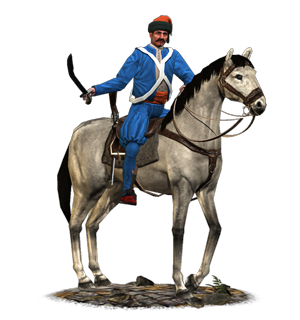Difference between revisions of "Mounted Nizam-I-Cedit (ETW Unit)"
Tango12345 (talk | contribs) |
Tango12345 (talk | contribs) m |
||
| Line 1: | Line 1: | ||
| − | |||
| − | |||
These mounted infantry ride into battle before delivering volleys of fire, but can fight on horseback if needed. | These mounted infantry ride into battle before delivering volleys of fire, but can fight on horseback if needed. | ||
Revision as of 10:39, 12 March 2012
These mounted infantry ride into battle before delivering volleys of fire, but can fight on horseback if needed.
Overview
They are armed with muskets, which are used dismounted in the manner of European-style dragoons, and fight with sabres when they attack while mounted. In either role, they are not quite as effective or efficient as properly specialised soldiers, but the flexibility that they give a commander in their use more than makes up for this lack. They should not be used as shock cavalry, but can prove useful as pursuit forces, or for riding down disorganised opposition.
Historically, the nizam-i-cedit were a "new model" army that used western European military doctrine and practices. The janissary corps vigorously opposed these foreign ideas, because they diminished warriors by expecting them to fight as parts in a machine rather than show individual bravery. This was not the right way to conduct wars, or for righteous men to act. The rest of the Ottoman army rather resented the nizam-i-cedit and the modernity they represented. After the new model corps was created, the second regiment, or orta, of nizam-i-cedit was trained and equipped to operate as mounted infantry rather than line infantry. This was a practical way of increasing mobility on and off the battlefield, and one that copied the original concept of dragoons.
